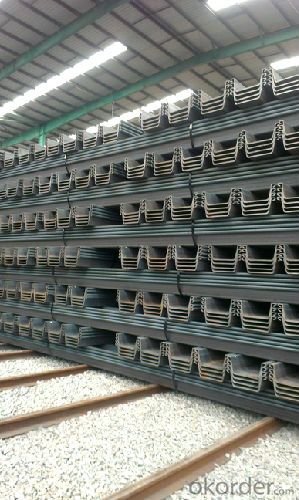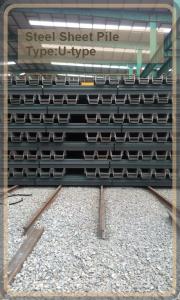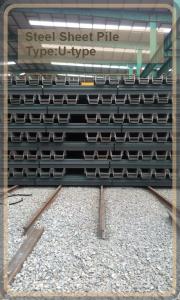Export Steel Sheet Pile/U Steel Sheet Pile/ 500*200*24.3mm
- Loading Port:
- China Main Port
- Payment Terms:
- TT or LC
- Min Order Qty:
- 200 Piece/Pieces m.t.
- Supply Capability:
- 10000 m.t./month
OKorder Service Pledge
OKorder Financial Service
You Might Also Like
Quick Details for Steel Sheet Piles
Place of Origin: China (Mainland)
Model Number: SD500/200-24.3
Material: Steel
Product name: Steel Sheet Pile
Steel sheet pile type: U-type
Steel sheet pile material: SY295
Steel sheet pile width: 500mm
Steel sheet pile height: 200mm
Steel sheet pile thickness: 24.3mm
Steel sheet pile length: 6m or 12m
Steel sheet pile loading: container , 20 ft or 40GP
Steel sheet pile used: temporary earth-retaining,temporary cofferdam works
Steel sheet pile weight: 105kgs / m
Packaging & Delivery
| Packaging Details: | packaging :by bulk . loading : container 20ft or 40GP |
|---|---|
| Delivery Detail: | stock ( more type has stock ) |
Export U Steel Sheet Pile 500*200*24.3mm
Product Description
Steel Sheet Pile Usage
temporary earth-retaining, temporary cofferdam works and permanent structures
Steel Sheet Pile Type : SD 500/200-24.3
Type | Size | Per piece | Per Meter of pile wall | ||||||||
Width | Height | Thickness | weight | section area | section moment | section modulus | section area | section moment | section modulus | weight | |
mm | mm | mm | kgs /m | cm2 | cm4 | cm3 | cm²/m | cm4/m | Cm³/m | kg/m² | |
SD500/200-24.3 | 500 | 200 | 24.3 | 105 | 133.8 | 7960 | 520 | 267.6 | 63000 | 3150 | 210 |
SD500/225-27.6 | 500 | 225 | 27.6 | 120 | 153 | 11400 | 680 | 306 | 86000 | 3820 | 2 |
Packaging & Shipping
Packing : it use container to load , 6M use 20ft container ; 12M use 40GP container .


Our Services
World leading manufacturer of cold-formed Sheet Pile.
Factory got a variety of quality certification : ISO9001:2000; ISO9001:2008.
Our products popular applicated for temporary earth-retaining, temporary cofferdam works and permanent structures
- Q:What is the difference between a laminated and non-laminated steel sheet?
- Laminated steel sheets, which are produced by bonding multiple layers of steel with adhesive or resin, are known for their increased strength and durability. This lamination process enhances their resistance to bending, impact, and corrosion. Additionally, it reduces noise and vibration in applications like automotive bodies or construction materials. In contrast, non-laminated steel sheets consist of a single layer of steel without undergoing the lamination process. While these sheets are still robust and long-lasting, they may not possess the same level of resistance to bending, impact, and corrosion as laminated steel sheets. They are commonly used in roofing, siding, and general fabrication. The key distinction between laminated and non-laminated steel sheets lies in their composition and properties. Laminated steel sheets offer superior strength, durability, and resistance to various forces, making them ideal for demanding applications where structural integrity is crucial. On the other hand, non-laminated steel sheets are more cost-effective and suitable for applications where high strength and durability are not the primary requirements.
- Q:What are the common thicknesses for corrugated steel sheets?
- The common thicknesses for corrugated steel sheets range from 0.5mm to 3mm, with 0.7mm and 1.2mm being the most commonly used thicknesses.
- Q:Are steel sheets suitable for chemical storage tanks?
- Yes, steel sheets are generally suitable for chemical storage tanks. Steel is known for its strength, durability, and corrosion resistance, making it a suitable material for storing a wide range of chemicals. However, the specific type of steel and its coating should be carefully selected to ensure compatibility with the chemicals being stored to prevent corrosion or contamination. Regular inspections and maintenance are also necessary to ensure the longevity and safety of steel storage tanks.
- Q:Can steel sheets be used for walkways or platforms?
- Certainly! Walkways or platforms can be constructed using steel sheets. Steel sheets are frequently employed in industrial and commercial settings owing to their durability, strength, and ability to withstand diverse environmental factors. They can be fabricated and installed to establish robust walkways or platforms capable of enduring heavy pedestrian traffic or the movement of equipment and machinery. Steel sheets can also be customized to fulfill specific design requirements, such as incorporating non-slip surfaces, raised edges for safety, or perforations for drainage. Furthermore, steel sheets necessitate relatively minimal upkeep and can be effortlessly cleaned and maintained, making them a perfect choice for walkways or platforms in various applications, including factories, warehouses, construction sites, and even outdoor areas.
- Q:What is the difference between a perforated and non-perforated steel sheet?
- A perforated steel sheet is a type of sheet metal that has small holes or perforations evenly spaced throughout the surface. These holes serve various purposes such as allowing for better airflow, drainage, or filtration. On the other hand, a non-perforated steel sheet does not have any holes and has a solid surface throughout. The main difference between the two is the presence or absence of these perforations, which determines their specific functions and applications.
- Q:How do steel sheets perform in high-pressure environments?
- Steel sheets perform well in high-pressure environments due to their high strength and resistance to deformation. They can withstand the forces exerted by high-pressure gases or liquids without significant distortion or failure.
- Q:What are the different sheet metal folding techniques for steel sheets?
- There are several sheet metal folding techniques that can be used for steel sheets. These techniques are commonly employed in various industries, such as automotive, aerospace, and construction, to create complex shapes and structures. Some of the most common sheet metal folding techniques for steel sheets include: 1. Box and Pan Folding: This technique involves bending the sheet metal along multiple parallel edges to create a box-like shape. It is commonly used to create enclosures, cabinets, and trays. 2. Hemming: Hemming is a technique used to fold the edges of a sheet metal component to increase its rigidity and eliminate sharp edges. It is often used in the automotive industry for creating panels and body parts. 3. Brake Press Folding: A brake press is a machine tool that utilizes a hydraulic or mechanical press to bend the sheet metal. It allows for precise and accurate folding by adjusting the angle and depth of the bend. Brake press folding is one of the most commonly used techniques in sheet metal fabrication. 4. Roll Forming: Roll forming is a continuous bending process where the sheet metal is passed through a series of rollers to gradually shape it into a desired profile. It is suitable for creating long and continuous shapes, such as tubes and channels. 5. Rotary Folding: In rotary folding, a rotating tool is used to fold the sheet metal along a curved or circular path. This technique is often used to create rounded edges, curves, and cylindrical shapes. 6. Folding Machines: Folding machines are specifically designed to fold sheet metal by applying pressure along a predetermined line. These machines can be programmed to perform various folding operations, including simple bends, complex shapes, and multiple folds. Each of these sheet metal folding techniques has its advantages and limitations, and the choice of technique depends on factors such as the complexity of the design, required precision, and production volume. Skilled craftsmen and specialized machinery are often employed to ensure accurate and efficient folding of steel sheets.
- Q:Are steel sheets suitable for architectural projects?
- Architectural projects can indeed utilize steel sheets as they offer numerous advantages. Steel, being a versatile and durable material, is highly suitable for such applications. First and foremost, steel sheets possess immense strength, enabling them to bear heavy loads. This makes them perfect for structural elements in buildings. The high strength-to-weight ratio of steel sheets allows for the creation of large and open spaces without the need for excessive supporting columns or walls. Consequently, steel sheets are ideal for constructing expansive interior spaces like atriums, stadiums, and other architectural projects. Furthermore, steel sheets can be easily shaped and formed into various architectural designs. They can be curved, rolled, or bent to fashion unique and intricate structures. Steel's malleability empowers architects and designers to challenge conventional building designs and create visually stunning and innovative structures. Moreover, steel sheets exhibit resistance to corrosion, weathering, and fire, making them suitable for outdoor applications and ensuring the longevity of architectural projects. The durability of steel also translates into minimal maintenance requirements throughout its lifespan, resulting in long-term cost savings. In addition, steel sheets offer a wide range of finishes, textures, and colors, facilitating customization and aesthetic versatility in architectural projects. Whether aiming for a sleek and modern design or a rustic and industrial look, steel sheets can be tailored to meet the desired aesthetic requirements of the project. To sum up, steel sheets are an excellent choice for architectural projects owing to their strength, versatility, durability, and aesthetic appeal. Their ability to withstand heavy loads, be shaped into various designs, resist corrosion and fire, and offer customization options make them a favored material for architects and designers to turn their visions into reality.
- Q:How are steel sheets tested for quality?
- Steel sheets are tested for quality through various methods, including visual inspection, measurement of dimensions, evaluation of surface defects, assessment of mechanical properties, and chemical composition analysis.
- Q:What are the standard tolerances for steel sheets?
- The standard tolerances for steel sheets can vary depending on the specific grade and thickness of the sheet. However, common industry standards set acceptable tolerances for dimensions such as length, width, and thickness. For example, a typical tolerance for length may be ±0.125 inches, for width ±0.062 inches, and for thickness ±10% of the nominal thickness. It is important to consult the relevant industry standards or specifications to determine the precise tolerances for a specific steel sheet.
1. Manufacturer Overview |
|
|---|---|
| Location | |
| Year Established | |
| Annual Output Value | |
| Main Markets | |
| Company Certifications | |
2. Manufacturer Certificates |
|
|---|---|
| a) Certification Name | |
| Range | |
| Reference | |
| Validity Period | |
3. Manufacturer Capability |
|
|---|---|
| a)Trade Capacity | |
| Nearest Port | |
| Export Percentage | |
| No.of Employees in Trade Department | |
| Language Spoken: | |
| b)Factory Information | |
| Factory Size: | |
| No. of Production Lines | |
| Contract Manufacturing | |
| Product Price Range | |
Send your message to us
Export Steel Sheet Pile/U Steel Sheet Pile/ 500*200*24.3mm
- Loading Port:
- China Main Port
- Payment Terms:
- TT or LC
- Min Order Qty:
- 200 Piece/Pieces m.t.
- Supply Capability:
- 10000 m.t./month
OKorder Service Pledge
OKorder Financial Service
Similar products
New products
Hot products
Related keywords































